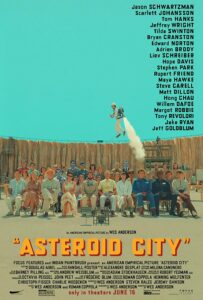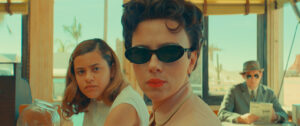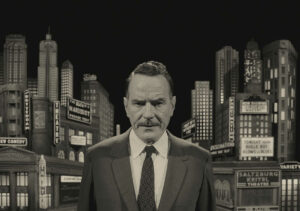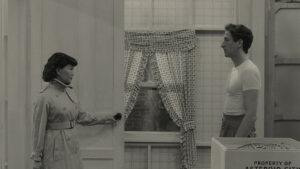Directed by Wes Anderson | Written by Anderson and Roman Coppola | 105 min | ▲▲▲△△
If you go back to my review of Anderson Feature #10, The French Dispatch, you’ll see it left me a little confused. I appreciated its very Andersonian qualities — art directed within an inch of its life, a disregard for anything approaching realism, the sprawling, spectacular cast, the twee, arch delivery of the dialogue — but I didn’t know how to feel about it. Months later I’m on an airplane and I decided to give the film a second go, and found I so enjoyed it. Not struggling to manage plot, I could observe all the weird and wonderful character and set details. That wasn’t enough, so I immediately watched it again before I landed.
My first impressions of Anderson Feature #11, Asteroid City, are similarly befuddled.
I think I have a better idea of what it’s about, though — set in the US of A in the mid-1950s, it’s a playful consideration of the culture of the day through the Andersonian lens: The optimism of looking to the stars, that undeniably American sense of exceptionalism, scientists, cowboys, Native Americans, teachers, movie stars, big cars, car chases, ridiculous aliens, and even a road runner that beeps. The title itself is indicative of a bigger deal than what’s actually there, where showbiz and marketing were born in good faith. Anderson must love all that artifice to have made an ode to it.
It also has that Nesting Doll thing, a little like Anderson did with The Grand Budapest Hotel, which for my money is still far and away his best work. This doesn’t come close to that masterpiece, but it still has plenty of the filmmaker’s particular charm, which is slowly evolving inward to even more formal structures.
We’re introduced to the film in a black and white, 4 x 3 framed mid-’50s TV show, hosted by Bryan Cranston. It’s a document of a famed playwright (Edward Norton) and the creation of his new play in an urban theatre arts milieu, all gritty and noirish.
From that we flip into the widescreen, brightly coloured and very artificial desert landscape (apparently shot in Spain, suggesting Anderson’s America doesn’t exist anywhere in America).
Asteroid City (pop. 87) is hosting a junior stargazer and space cadet conference, young geniuses and their families gather to share their wildly advanced science experiments. The film bounces back and forth between these worlds, constantly reminding us of the lack of authenticity in both.
Naturally, Anderson fills the frame with detail — I suspect it would take multiple viewings to appreciate it all, just like my experience of his last one. He also fills it with an immensely recognizable cast. A partial list: Jeffrey Wright, Tilda Swinton, Liev Shreiber, Hope Davis, Steve Carrell, with Scarlett Johansson as the movie star and Jason Schwartzman as the war photographer. Tom Hanks shows up in a role that Anderson must have imagined for Bill Murray, which makes you wonder why it wasn’t Bill. He’s been Anderson’s lucky charm going back to Rushmore.
Anderson’s also got a knack with incorporating the perspective of children, something he did so well in Rushmore and Moonrise Kingdom. The kids here are delightful, but maybe too much on the margins of the story to make much of an impact.
Asteroid City is curious, whimsical, maybe even thoughtful. A day later and it hasn’t stayed with me, but there’s absolutely nothing like it in American movies. Maybe I’ll dial it up the next time I’m on a transatlantic flight.
















